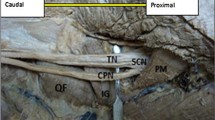Abstract
Anatomic anomalies such as bipartite piriformis muscle or the sciatic nerve course/branching variations with respect to the piriformis muscle as seen in >80% of the population, the sciatic nerve courses deep to and exits inferiorly to the piriformis muscle belly/tendon.
Access provided by Autonomous University of Puebla. Download chapter PDF
Similar content being viewed by others
-
1.
Anatomic anomalies such as bipartite piriformis muscle or the sciatic nerve course/branching variations with respect to the piriformis muscle as seen in >80% of the population, the sciatic nerve courses deep to and exits inferiorly to the piriformis muscle belly/tendon.
It is also known to occur in early (proximal) divisions of the sciatic nerve into its tibial and common peroneal components can predispose patients to piriformis syndrome, with these branches passing through and below the piriformis muscle or above and below the muscle.
-
2.
Buttock Pain: Piriformis syndrome causes radiating pain originating in the buttock which may radiate down the leg. The sciatic nerve becomes impinged by the Piriformis muscle, deep in the buttocks resulting in (1) Buttock pain which may (2) may radiate down the back of the thigh and may extend into the calf muscles.
-
3.
Piriformis syndrome is not very common as it causes only about 0.3% to 6% of lower back pain. It may be a painful musculoskeletal condition which may be caused by stretched Piriformis muscle, leading to inflammation of soft tissue, muscle spasms, or both, resulting in nerve compression.
-
4.
Myofascial trigger points may be single like medial piriformis trigger point lies along the piriformis line about an inch outside the edge of the sacrum which is a large, triangular bone at the base of the spine or double which refer pain and tenderness to the sacroiliac joint, gluteal, and hip regions.
-
5.
Predisposing anatomic variants namely 6 types such as:
-
Type A: typical pattern with the SN passing below the PM, undivided
-
Type B: the CPN exits through the PM and TN exits below the PM
-
Type C: the CPN exits above the PM and TN and below the PM
-
Type D: the SN exits through the PM, as a single trunk
-
Type E: the CPN exits above the PM and TN through the PM, and
-
Type F: the SN passes undivided above the PM as seen in the Fig. 1.
-
6.
Secondary to laminectomy leading to Acute Sciatic Neuritis.
-
7.
Bursitis of the Piriformis muscle: It can also occur in the buttocks when it is called ischial bursitis wic can be symptomatic and seen as pain when sitting or lying down or pain at the back of the thigh or swelling with redness in the affected area.
-
8.
Degenerative disc disease: This happens with due to age and may cause pain in the buttocks and thighs at times with numbness and tingling in the legs which increases on sitting, lifting or bending.
-
9.
Pilonidal cyst which may be found in the cleft between a person’s buttocks and differs in containing tiny bits of hair and skin.
-
10.
Perianal abscess which may be infected and filled with pus.
-
11.
Sacroiliac joint dysfunction resulting in pain in the lower back, buttocks, and upper legs.
-
12.
Arthritis of the hips giving rise to raditing pain in te lower back, hips and thighs.
-
13.
Vascular disease may experience pain radiating in the buttocks due to blockage of blood vessels.
-
Author information
Authors and Affiliations
Corresponding author
Editor information
Editors and Affiliations
Rights and permissions
Copyright information
© 2023 The Author(s), under exclusive license to Springer Nature Switzerland AG
About this chapter
Cite this chapter
Mohan Iyer, K. (2023). Aetiology of PS. In: Iyer, K.M. (eds) Piriformis Syndrome. Springer, Cham. https://doi.org/10.1007/978-3-031-40736-9_4
Download citation
DOI: https://doi.org/10.1007/978-3-031-40736-9_4
Published:
Publisher Name: Springer, Cham
Print ISBN: 978-3-031-40735-2
Online ISBN: 978-3-031-40736-9
eBook Packages: MedicineMedicine (R0)





